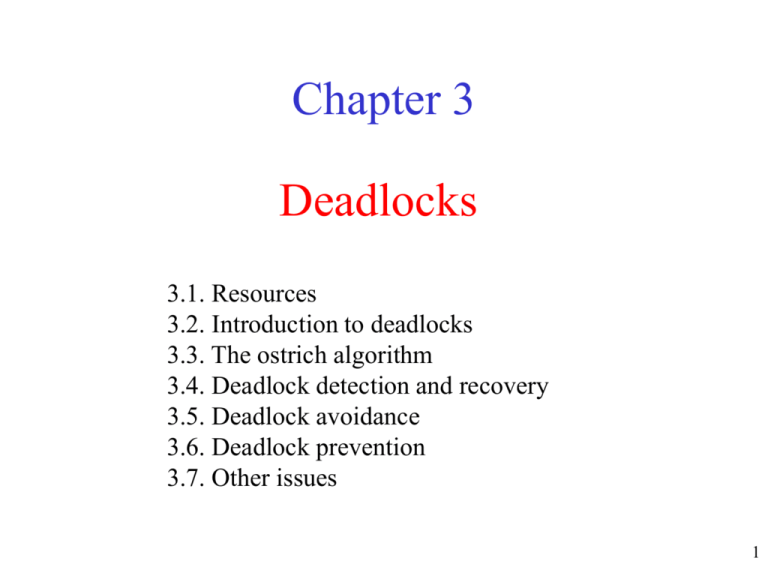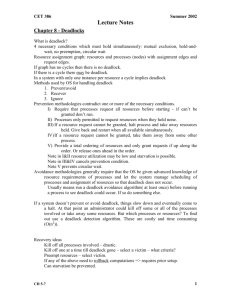Deadlocks
advertisement

Chapter 3 Deadlocks 3.1. Resources 3.2. Introduction to deadlocks 3.3. The ostrich algorithm 3.4. Deadlock detection and recovery 3.5. Deadlock avoidance 3.6. Deadlock prevention 3.7. Other issues 1 Resources • Examples of computer resources – printers – tape drives – tables • Processes need access to resources in reasonable order • Suppose a process holds resource A and requests resource B – at same time another process holds B and requests A – both are blocked and remain so 2 Resources (1) • Deadlocks occur when … – processes are granted exclusive access to devices – we refer to these devices generally as resources • Preemptable resources – can be taken away from a process with no ill effects • Nonpreemptable resources – will cause the process to fail if taken away 3 Resources (2) • Sequence of events required to use a resource 1. request the resource 2. use the resource 3. release the resource • Must wait if request is denied – – requesting process may be blocked may fail with error code 4 Introduction to Deadlocks • Formal definition : A set of processes is deadlocked if each process in the set is waiting for an event that only another process in the set can cause • Usually the event is release of a currently held resource • None of the processes can … – run – release resources – be awakened 5 Four Conditions for Deadlock Mutual exclusion condition 1. • each resource assigned to 1 process or is available Hold and wait condition 2. • process holding resources can request additional No preemption condition 3. • previously granted resources cannot be forcibly taken away Circular wait condition 4. • • must be a circular chain of 2 or more processes each is waiting for resource held by next member of the chain 6 Deadlock Modeling (2) • Modeled with directed graphs – resource R assigned to process A – process B is requesting/waiting for resource S – process C and D are in deadlock over resources T and U 7 Deadlock Modeling (3) Strategies for dealing with Deadlocks just ignore the problem altogether detection and recovery dynamic avoidance 1. 2. 3. careful resource allocation • 4. prevention • negating one of the four necessary conditions 8 Deadlock Modeling (4) A B How deadlock occurs C 9 Deadlock Modeling (5) (o) (p) How deadlock can be avoided (q) 10 The Ostrich Algorithm • Pretend there is no problem • Reasonable if – deadlocks occur very rarely – cost of prevention is high • UNIX and Windows takes this approach • It is a trade off between – convenience – correctness 11 Detection with One Resource of Each Type (1) • Note the resource ownership and requests • A cycle can be found within the graph, denoting deadlock 12 Detection with One Resource of Each Type (2) Data structures needed by deadlock detection algorithm 13 Detection with One Resource of Each Type (3) An example for the deadlock detection algorithm 14 Recovery from Deadlock (1) • Recovery through preemption – take a resource from some other process – depends on nature of the resource • Recovery through rollback – checkpoint a process periodically – use this saved state – restart the process if it is found deadlocked 15 Recovery from Deadlock (2) • Recovery through killing processes – – – – crudest but simplest way to break a deadlock kill one of the processes in the deadlock cycle the other processes get its resources choose process that can be rerun from the beginning 16 Deadlock Avoidance Resource Trajectories Two process resource trajectories 17 Safe and Unsafe States (1) (a) (b) (c) (d) (e) Demonstration that the state in (a) is safe 18 Safe and Unsafe States (2) (a) (b) (c) (d) Demonstration that the sate in b is not safe 19 The Banker's Algorithm for a Single Resource (a) (b) (c) • Three resource allocation states – safe – safe – unsafe 20 Banker's Algorithm for Multiple Resources Example of banker's algorithm with multiple resources 21 Deadlock Prevention Attacking the Mutual Exclusion Condition • Some devices (such as printer) can be spooled – only the printer daemon uses printer resource – thus deadlock for printer eliminated • Not all devices can be spooled • Principle: – avoid assigning resource when not absolutely necessary – as few processes as possible actually claim the resource 22 Attacking the Hold and Wait Condition • Require processes to request resources before starting – a process never has to wait for what it needs • Problems – may not know required resources at start of run – also ties up resources other processes could be using • Variation: – process must give up all resources – then request all immediately needed 23 Attacking the No Preemption Condition • This is not a viable option • Consider a process given the printer – halfway through its job – now forcibly take away printer – !!?? 24 Attacking the Circular Wait Condition (1) (a) (b) • Normally ordered resources • A resource graph 25 Attacking the Circular Wait Condition (1) Summary of approaches to deadlock prevention 26 Other Issues Two-Phase Locking • Phase One – process tries to lock all records it needs, one at a time – if needed record found locked, start over – (no real work done in phase one) • If phase one succeeds, it starts second phase, – performing updates – releasing locks • Note similarity to requesting all resources at once • Algorithm works where programmer can arrange – program can be stopped, restarted 27 Nonresource Deadlocks • Possible for two processes to deadlock – each is waiting for the other to do some task • Can happen with semaphores – each process required to do a down() on two semaphores (mutex and another) – if done in wrong order, deadlock results 28 Starvation • Algorithm to allocate a resource – may be to give to shortest job first • Works great for multiple short jobs in a system • May cause long job to be postponed indefinitely – even though not blocked • Solution: – First-come, first-serve policy 29





